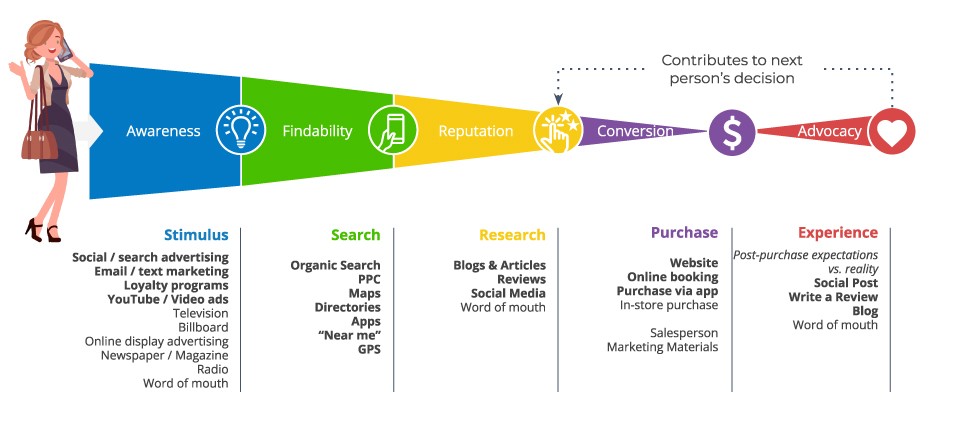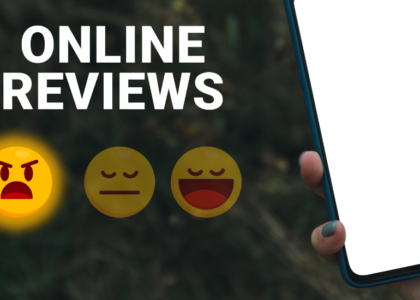Building a customer journey map is easy, and it’s an effective way to learn more about your customers.
To build your own customer journey map, follow the steps below.
Customer journey maps are useful marketing tools that can help you better understand your target audience and use that information to lead them down a path to conversion. All businesses can benefit from having a customer journey map, so whether you’re doing B2B marketing or building an e-commerce brand, it’s good to know how customers interact with your company.

Building a Customer Journey Map
Determine your business goals. You’ll need to determine your goals before establishing the touchpoints for your customer journey map. Goals can include converting more qualified leads into customers, increasing brand awareness, and so on.
- Understand your customers. Gather data on your customers to learn about their behavior and uncover new ways to market to them.
- List opportunities for communication. Consider all the different ways you can communicate with customers, including social media and email marketing.
- Test your customer journey. Pretend you’re the customer and test your journey to see how you can make it easy for customers to convert after their initial touchpoint with your business.
- Refine customer journey map if necessary. Refine your customer journey map when there are changes to your business. Breaking down the map into stages can help you meet your customers’ needs no matter where they are in their journeys.
Request a Customer Journey Map
- Reduce your bounce rate
- Improve your customer experience
- Retain your online shoppers
- Predict future activity
Advantages of a customer journey map
Customer journey maps are useful marketing tools that can help you better understand your target audience and use that information to lead them down a path to conversion. All businesses can benefit from having a customer journey map, so whether you’re doing B2B marketing or building an e-commerce brand, it’s good to know how customers interact with your company.
A few other advantages of a customer journey map include:
- Understand consumer behavior. Understanding how users interact with your brand can help you comprehend their motivations.
- Identify touchpoints. Identifying the different interactions customers have with your brand before making a purchase can help you create more effective marketing campaigns.
- Support your marketing efforts. Learning as much as you can about your customers can improve marketing performance by allowing you to shorten the customer journey and increase conversions.
- Improve the customer experience. With customer data, you can improve customers’ experiences with your brand, making them more likely to convert.
- Predict how customers will behave. Customer journey maps help you predict what customers will do next, allowing you to market to them no matter where they are in the funnel.
- Boost customer loyalty and engagement. By creating a path for your customers and providing great experiences, you can keep customers coming back for more. This makes customer journey mapping an essential customer retention strategy.
How does marketing automation benefit the customer journey?
Marketing automation uses technologies that eliminate the need for you to send one-off emails or set up other marketing efforts every time you need to connect with customers. Basically, you set up an automation to execute your strategy the way you want, and it’ll do the marketing work for you.
Since automations are usually powered by if-then logic, they adapt to match the individual paths your customers take.
For example, before making a purchase people might read your website, consider what product they want, sleep on it, and eventually go back to buy. This wandering route is different for everyone. With automation, you can automatically send an email during the consideration stage of their journey, reminding them of the products they were interested in and encouraging them to finalize the purchase.
Here are a few ways automation can help you build lasting relationships by connecting with customers at each step of their journey with your business.
Connect with new fans
When someone expresses interest in what you have to offer and enters their email address in a subscriber pop-up form on your site, you can send them a welcome email to introduce yourself—and give them a reason to stick around. You can also provide information about how often they’ll receive marketing correspondence from your business.
Sell more stuff
When that contact starts to move toward a purchase, such as putting something in their cart without checking out, you can set it up so they receive an abandoned cart email from you.
Meanwhile, you can send occasional reminders to prospects that haven’t interacted with you in a while. Retargeting ads and emails, for example, remind people about the great stuff they saw on your site. Chances are, at least some of them are still interested and will take action if you reach out.
Cultivates a trusting 2-way relationship
When you deliver relevant content to your customers, you show them that you care about them. The more you target your communications, the more they will trust you to keep providing high-quality products or services. You can even use automation to send coupons or other discounts to people that meet certain criteria for loyalty or spending.
Sources
Vendasta marketing Platform, Mailchimp, SEM Rush, and Local IQ




